An exceptionally rare Imperial famille rose yellow-ground 'floral' bowl Qianlong six-character mark and of the period
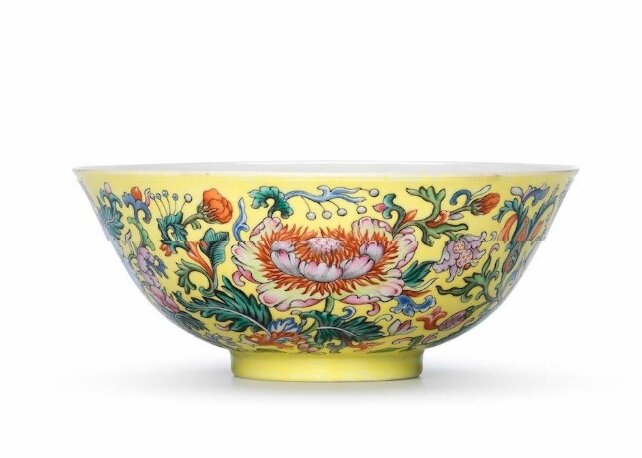


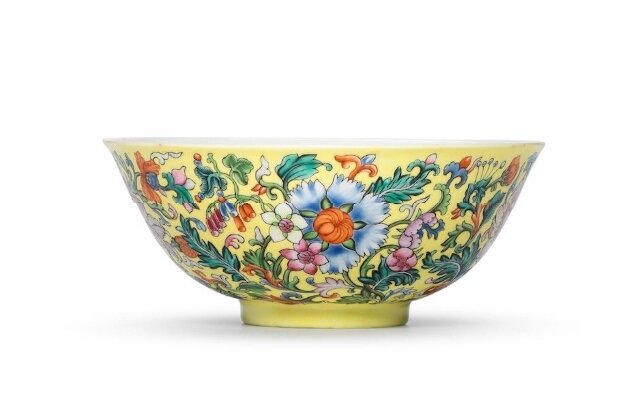

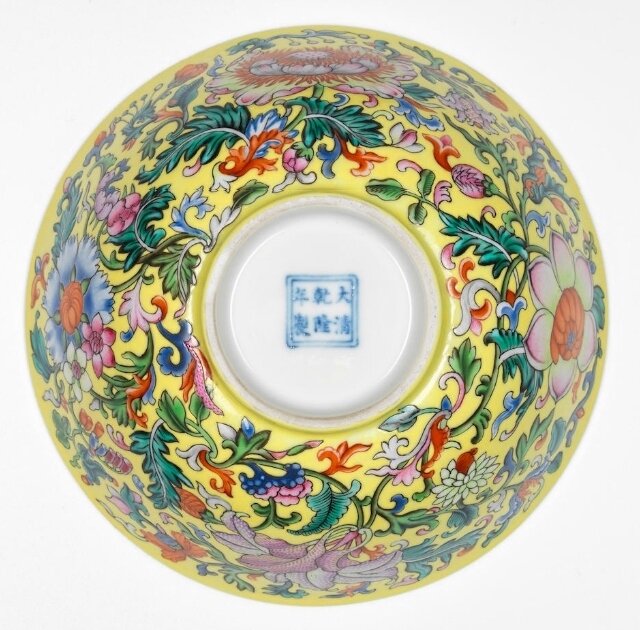




Lot 122. An exceptionally rare Imperial famille rose yellow-ground 'floral' bowl, Qianlong six-character mark and of the period (1736-1795). Estimate HK$ 800,000 - 1,200,000 (€94,000 - 140,000). Photo: Bonhams.
Finely enamelled in vibrant colours of pink, white, blue, coral-red and green with various blossoms including lily, narcissus, lotus and anemone, all borne on dense leafy scrolls with further florets reserved on a bright yellow ground, the interior decorated with five iron-red bats, the base with a six-character kaishu mark in underglaze blue. 15.1cm (6in) diam.
Provenance: An important European private collection formed during the first half of the 20th century, and thence by descent. This lot is the pair to the bowl sold in these rooms on 29 November 2016, lot 25.
Note: The European collector (1880-1952) was an entrepreneur with early links to Russia and Japan. From 1911-1917 he lived in St. Petersburg where he owned a company selling high-quality stainless steel, and where he learned the Russian language. Although he first visited Japan in 1907, it was in 1920 that he returned home to set up a sales operation similar to that in St. Petersburg which had been halted three years earlier due to the political upheaval. He spent several years in Osaka and Kobe, when his interest in Japanese works of art commenced. Once again he realised the benefit of learning the language in order to facilitate the acquiring of works of art. The result was a fine collection of woodblock prints, netsuke, inro, porcelain (in particular Kakiemon vases), swords, lacquer and silver. It was in the 1930s when back in Japan, that he extended his collection to include Chinese art. Fine porcelain, Tang silver, and early bronzes were his particular interests, and he studied these subjects both in books and through his discussions with his friend Kusaka Shogado, who was a leading dealer based in Kyoto, and from whom he made many purchases. He visited Japan for the last time in 1938, when he bought numerous items for his collection.
The present bowl is exceptionally rare and only four other examples with a Qianlong regular kaishu six-character mark and of the period appear to have been published; one in the Shanghai Museum, illustrated by Wang, Zhongguo Taoqi, Jingdezhen Caihui Ciqi, Shanghai, pl.III and Chugoku Toji Zenshu, vol.21, pl.111; the second in the Wang Xing Lou collection, see Imperial Perfection: The Palace Porcelain of Three Chinese Emperors, Kangxi - Yongzheng - Qianlong, Hong Kong, 2004, pp.158-159, no.57; the third was previously with S.Marchant & Son, Ltd., London, in 2006, and later sold at Sotheby's Hong Kong on 4 April 2012, lot 3190; and the fourth example, the pair to the present lot, was sold in these rooms on 29 November 2016, lot 25.
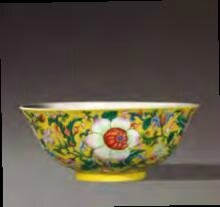
Image courtesy of the Wang Xing Lou Collection
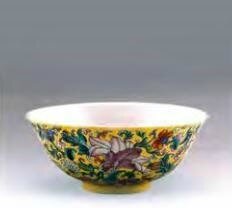
Image courtesy of the Shanghai Museum

Superbly enamelled with full flowering blossoms, demonstrating the exceptional level of aesthetic and technical craftsmanship achieved during the Qianlong reign, the same design is also shared by a number of bowls with a Qianlong underglaze-blue seal mark as well as by bowls with a Qianlong blue-enamel four-character seal mark. For bowls with underglaze-blue six-character seal marks, see one in the British Museum, London (14cm diam.), illustrated by H.Moss, By Imperial Command, Hong Kong, 1976, pl.6; another example from the Qing Court collection, Palace Museum, Beijing, is illustrated in The All Complete Qianlong: The Aesthetic Tastes of the Qing Emperor Gaozong, Taipei, 2013, pp.220-221, pl.II-3.28; another one is in the Nanjing Museum (18.5cm diam.), illustrated in Treasures in the Royalty: The Official Kiln Porcelain of the Chinese Qing Dynasty, Shanghai, 2003, p.243. For an example of a blue-enamel four-character seal mark bowl, see Geng Baochang, Ming Qing Ciqi Jianding, Hong Kong, 1993, p.281, fig.485.
This decorative design on bowls continued into the Daoguang period, indicating the particular popularity of this design at the Imperial court; see S.G.Valenstein et al., The World's Great Collections: Oriental Ceramics, Vol.11: The Metropolitan Museum of Art, New York, Tokyo, 1982, pl.163; see also a pair of famille rose yellow-ground 'floral' bowls, Daoguang seal marks and of the period, which was sold at Sotheby's Hong Kong on 5 October 2011, lot 2069.
Bonhams. FINE CHINESE CERAMICS AND WORKS OF ART, 30 May 2017, 15:00 HKT, HONG KONG, ADMIRALTY

/https%3A%2F%2Fprofilepics.canalblog.com%2Fprofilepics%2F1%2F0%2F100183.jpg)
/https%3A%2F%2Fstorage.canalblog.com%2F03%2F02%2F119589%2F96711876_o.jpg)
/https%3A%2F%2Fstorage.canalblog.com%2F11%2F31%2F119589%2F94773502_o.jpg)
/https%3A%2F%2Fstorage.canalblog.com%2F20%2F83%2F119589%2F94772815_o.jpg)
/https%3A%2F%2Fstorage.canalblog.com%2F26%2F72%2F119589%2F75604929_o.jpg)
/https%3A%2F%2Fstorage.canalblog.com%2F59%2F60%2F119589%2F26458628_o.jpg)


/http%3A%2F%2Fstorage.canalblog.com%2F58%2F04%2F119589%2F128167118_o.jpg)
/http%3A%2F%2Fstorage.canalblog.com%2F56%2F88%2F119589%2F127649882_o.jpg)
/http%3A%2F%2Fstorage.canalblog.com%2F82%2F49%2F119589%2F127238728_o.jpg)
/http%3A%2F%2Fstorage.canalblog.com%2F74%2F56%2F119589%2F127152951_o.jpg)